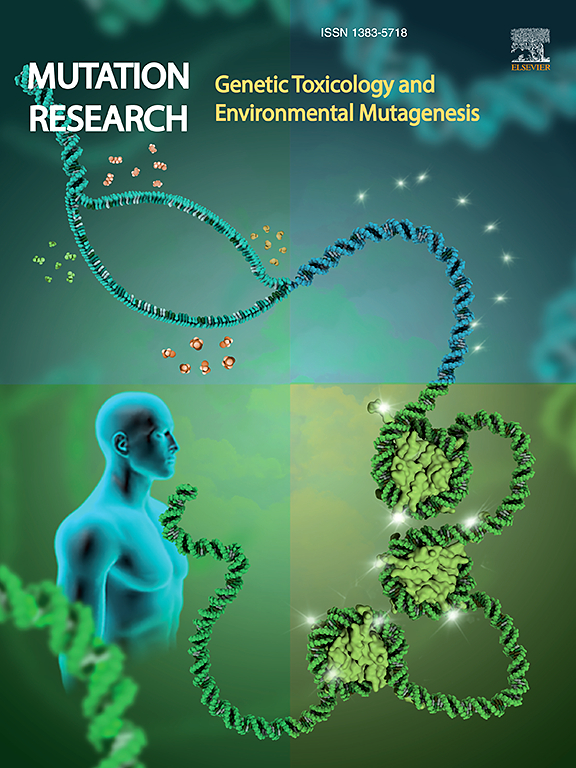DNA damage and nuclear anomalies in peripheral blood lymphocytes from asthma patients and obese individuals
IF 2.5
4区 医学
Q3 BIOTECHNOLOGY & APPLIED MICROBIOLOGY
Mutation research. Genetic toxicology and environmental mutagenesis
Pub Date : 2025-09-12
DOI:10.1016/j.mrgentox.2025.503889
引用次数: 0
Abstract
Asthma is a chronic, non-communicable respiratory disorder affecting approximately 262 million people worldwide, with India projected to become one of the leading countries in prevalence. Asthma is well-established as a condition of chronic inflammation of the airways and related to systemic oxidative stress, but relatively not much is known about the genomic instability associated with asthma. On the other hand, obesity is found in 650 million people worldwide and 113 million people in India. Studies reported links between asthma and obesity, which include adipose tissue dysfunction and inefficient blood monocyte efferocytosis. Obesity enhances reactive oxygen species (ROS) production and inflammation, leading to DNA lesions. Thus, the aim of this study was to assess the DNA damage and frequencies of micronuclei (MNi), nucleoplasmic bridges (NPB), and nuclear buds (NBUD) in the lymphocytes of asthma patients and obese individuals. This study evaluates the DNA damage and nuclear anomalies in (n = 435) subjects (asthma patients n = 100, asthmatic obese patients n = 131, obese n = 100 and controls n = 104). An alkaline comet assay was used to assess DNA damage and nuclear anomalies were assessed by cytokinesis block micronucleus cytome (CBMN-Cyt) assay. All subjects were recruited between the age of 20 and 60 years. The total DNA damage, MNi, and frequency of total nuclear anomalies were found to be significantly higher in asthma male and female patients, asthmatic obese male and female patients, and obese males and females in comparison to control males and females (p < 0.05). The total comet score showed a positive correlation with the frequency of total nuclear anomalies in asthma male and female patients and obese males, respectively. Overall the findings demonstrate that inflammation and oxidative stress in asthma and obesity lead to DNA damage and genomic instability.
哮喘患者和肥胖者外周血淋巴细胞DNA损伤和核异常
哮喘是一种慢性非传染性呼吸系统疾病,影响全球约2.62亿人,印度预计将成为患病率最高的国家之一。众所周知,哮喘是一种气道慢性炎症,与全身氧化应激有关,但相对而言,人们对哮喘相关的基因组不稳定性知之甚少。另一方面,全球有6.5亿人肥胖,印度有1.13亿人肥胖。研究报告了哮喘和肥胖之间的联系,包括脂肪组织功能障碍和低效率的血液单核细胞efferocytosis。肥胖增加活性氧(ROS)的产生和炎症,导致DNA损伤。因此,本研究的目的是评估哮喘患者和肥胖者淋巴细胞中微核(MNi)、核质桥(NPB)和核芽(NBUD)的DNA损伤和频率。本研究评估的DNA损伤和核异常(n = 435)科目(哮喘患者n = 100,哮喘肥胖病人n = 131,肥胖n = 100和控制 = 104)。用碱性彗星法评估DNA损伤,用细胞分裂阻断微核细胞组(cmbn - cyt)法评估核异常。所有受试者的年龄都在20至60岁之间。哮喘男女患者、哮喘肥胖男女患者、肥胖男女患者的总DNA损伤、MNi、总核异常频率均明显高于对照组(p <; 0.05)。在哮喘男女患者和肥胖男性患者中,彗核总得分分别与总核异常频率呈正相关。总的来说,研究结果表明哮喘和肥胖中的炎症和氧化应激会导致DNA损伤和基因组不稳定。
本文章由计算机程序翻译,如有差异,请以英文原文为准。
求助全文
约1分钟内获得全文
求助全文
来源期刊
CiteScore
3.80
自引率
5.30%
发文量
84
审稿时长
105 days
期刊介绍:
Mutation Research - Genetic Toxicology and Environmental Mutagenesis (MRGTEM) publishes papers advancing knowledge in the field of genetic toxicology. Papers are welcomed in the following areas:
New developments in genotoxicity testing of chemical agents (e.g. improvements in methodology of assay systems and interpretation of results).
Alternatives to and refinement of the use of animals in genotoxicity testing.
Nano-genotoxicology, the study of genotoxicity hazards and risks related to novel man-made nanomaterials.
Studies of epigenetic changes in relation to genotoxic effects.
The use of structure-activity relationships in predicting genotoxic effects.
The isolation and chemical characterization of novel environmental mutagens.
The measurement of genotoxic effects in human populations, when accompanied by quantitative measurements of environmental or occupational exposures.
The application of novel technologies for assessing the hazard and risks associated with genotoxic substances (e.g. OMICS or other high-throughput approaches to genotoxicity testing).
MRGTEM is now accepting submissions for a new section of the journal: Current Topics in Genotoxicity Testing, that will be dedicated to the discussion of current issues relating to design, interpretation and strategic use of genotoxicity tests. This section is envisaged to include discussions relating to the development of new international testing guidelines, but also to wider topics in the field. The evaluation of contrasting or opposing viewpoints is welcomed as long as the presentation is in accordance with the journal''s aims, scope, and policies.

 求助内容:
求助内容: 应助结果提醒方式:
应助结果提醒方式:


